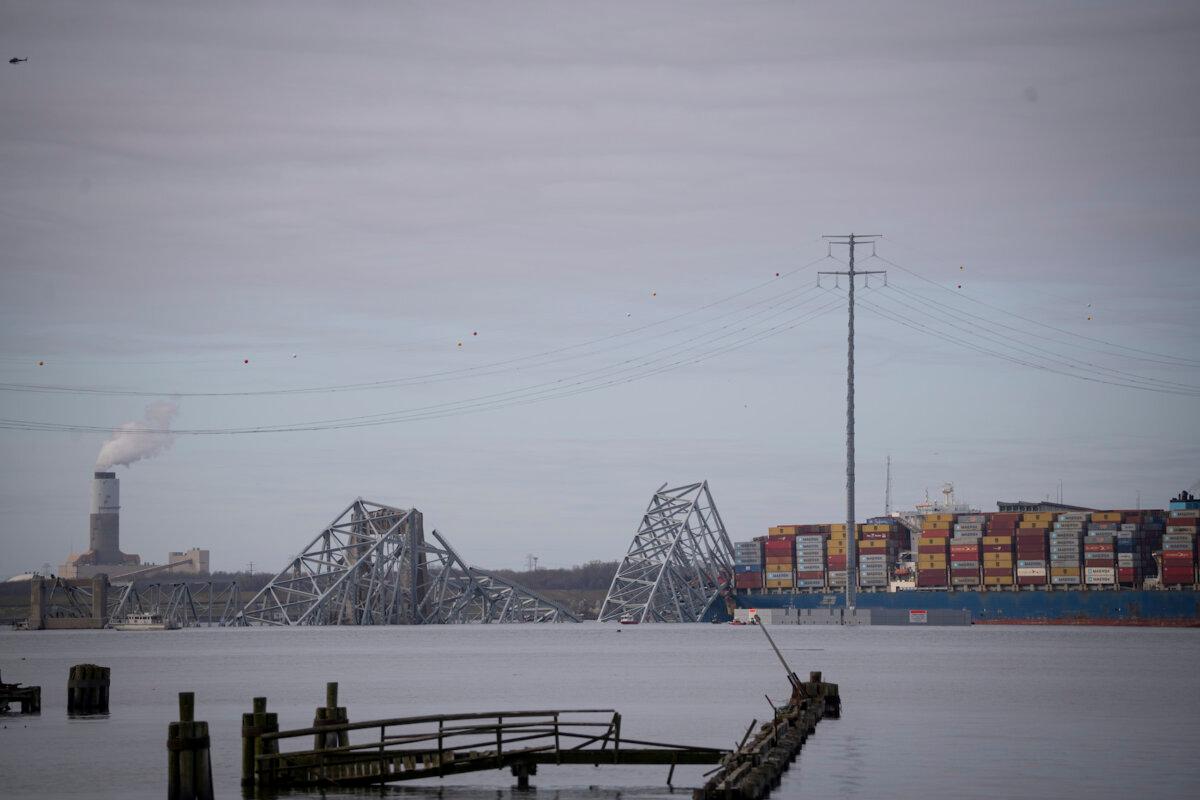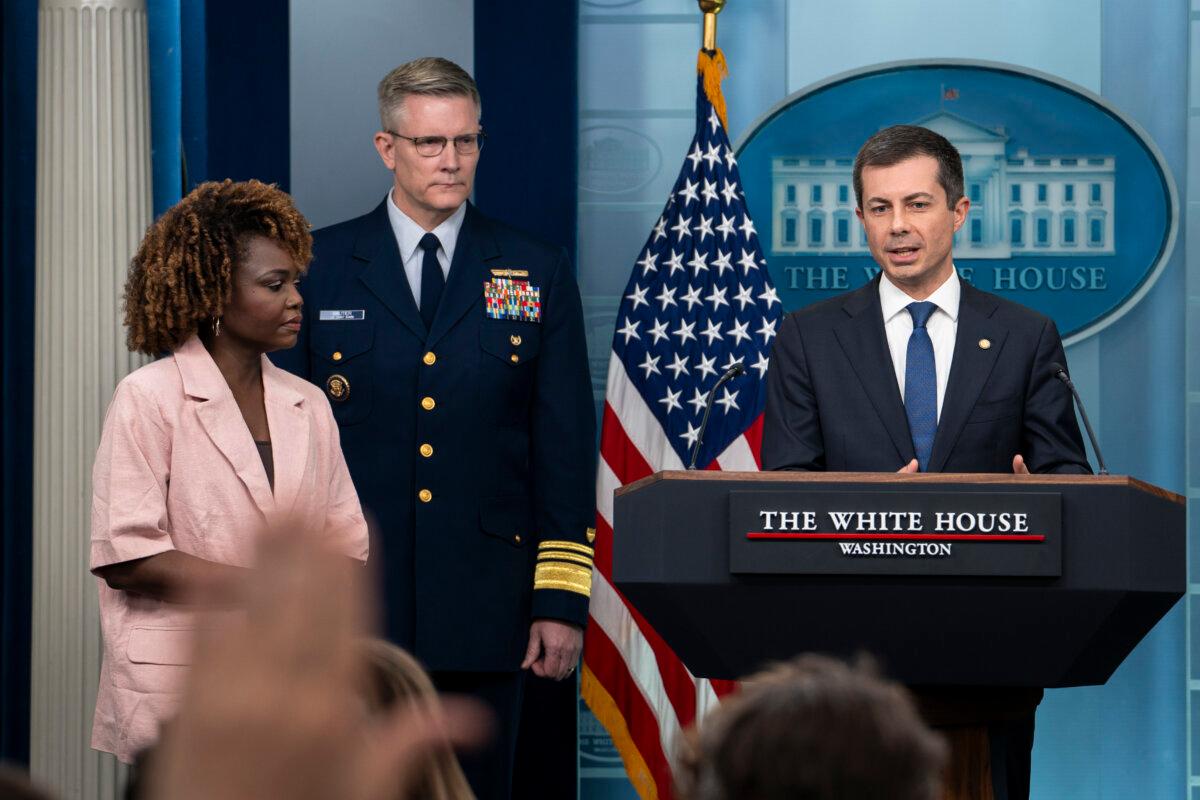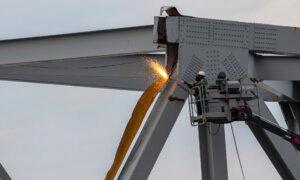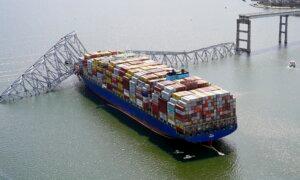Growing chorus say Biden’s $20 billion ports plan needs big boost to reverse decades of infrastructure neglect that now imperils commerce, national security.
President Joe Biden, in an executive order this February, directed $20 billion in allocations from the 2021 Bipartisan Infrastructure Bill (BIL) into a five-year grant program dedicated to modernizing America’s 361 commercial ports.
“But if you put it in context of a $1.2 trillion infrastructure” package approved under the 2021 BIL and 2022’s Inflation Reduction Act, “it’s less than 1 percent. In that context, it’s not a lot of money,” he told The Epoch Times.
With the nation’s ninth-busiest commercial port sitting idle since the Singapore-flagged 95,000-ton Dali knocked down Baltimore’s Francis Scott Key Bridge on March 26, there’s added intensity to years-long calls to upgrade ports to safely accommodate megaship container carriers. Only a handful of U.S. ports can, and improvements are needed to buttress supply chains that generate $5.4 trillion in annual domestic economic activity.
“The problem is, if you look at how much money we spend in that infrastructure bill on maritime, it is a fraction” of what is needed, said Dr. Salvatore Mercogliano, a professor who analyzes maritime commerce at Campbell University in Buies Creek, North Carolina.
There’s even less federal policy dedicated to maritime commerce than federal money for ports, he told The Epoch Times.
“You actually had the Secretary of Transportation [Pete Buttigieg] at a press conference” on the Dali crash “come out and say, ‘You know, there’s really no one in charge’” of national maritime policy and that the U.S. Maritime Administration (MARAD) “‘doesn’t have the power the FAA does to control air, so there’s no central place that should be looking out for ports and maritime policy,’ which I think is an inherent flaw in the government’s oversight of shipping.”
As a result, he said, “There’s no cohesive national strategy. So you have ports competing with each other, costing taxpayers money so they can get the ships” that concentrate commerce in ports that can get bigger, while those that cannot become backwaters, leaving supply chains—and national security—vulnerable should a mishap, natural disaster, military attack, or terrorist act sink one ship or bring down one bridge to block one port’s sea lanes, ensnarling the flow of goods nationwide.

Global Issue, American Crisis
Before the Dali’s crash into the Key Bridge shut down an important U.S. port for what could be weeks, there were many glaring, blinking red warnings that global maritime supply chains are increasingly vulnerable to challenges, ranging from low-water conditions in the Panama Canal, 2020-21 pandemic disruptions, megaship groundings like the one in March 2021 that shut down the Suez Canal for weeks, and Houthi missile attacks on ships in the Red Sea.
Those global aggravations were amplified in the United States in November 2021 when the Port of Los Angeles—the nation’s largest seaport—was overwhelmed by container carriers in a weeks’ long backlog that accelerated inflation and disrupted commerce nationwide.
Mr. Darr, a U.S. citizen, said the world was watching when the nation’s largest seaport’s “land-based logistics capacity could not efficiently process all the import cargo that was arriving” in Los Angeles.
“We are hopeful that Congress’s subsequent investments in U.S. port and land-side infrastructure will, at some point, provide additional capacity and resiliency to handle similar future supply-and-demand surges caused by geopolitical and other unanticipated major events,” he said.
“Unanticipated major events” would include a megaship knocking down a bridge and blocking sea lanes.
While much of the traffic normally routed through Baltimore—the East Coast’s biggest imported automobile entry port—can be accommodated without dramatic economic consequences, there are relatively few U.S. ports that can absorb a significant increase in volume.
Capt. Konrad has been among maritime commerce advocates lobbying for more federal focus on the nation’s ports and merchant shipping policies for years.
“It’s like all the seaports and river ports and waterways across the entire country get less than … a fraction of what [the Biden administration] is giving to electric buses,” he said.
Rather than the U.S. Department of Transportation (DOT) and Defense Department spending a combined $8 billion on electric buses, he suggested it be shifted to the Maritime Administration (MARAD) for port improvements and expansions.
The administration’s meager investment in ports and maritime commerce “makes no sense,” Capt. Konrad said, “especially considering that shipping [emits less] carbon emissions. So if they want to save the planet, that’s where you put the money. But they don’t.”

Long Sad Story
None of this, however, is new, Capt. Konrad said.
“It’s been a complete and utter failure by the Department of Transportation over decades,” he said, a slide that began in the 1960s that has accelerated since the early 2000s beginning with the Bush administration.
With the post-9/11 creation of the Department of Homeland Security (DHS), MARAT and other federal maritime commerce agencies have “suffered continuous budget cuts and sniping by the DHS leadership,” Capt. Konrad said.
“Meanwhile,” he continued, “what is left is a tiny shell of an agency called Maritime Administration [MARAD]. The DOD and FAA have over 40,000 employees. MARAD has 800, so they’re completely unable to accomplish anything and over at DHS, they [control] the Coast Guard budget and give them more things to do.”
“How can you help [free-trade Washington-based think tank] CATO dismantle the Jones Act and undermine American shipping? How can you subvert crucial U.S. Navy shipbuilding subsidies? How can you obstruct $1.2 trillion of infrastructure bill funding from supporting ports and marine highways?” he asked in an October column. “How can you perpetuate the influx of Chinese goods arriving at U.S. ports on Chinese vessels? Simply refuse to answer the phone.”
MARAD “is broken and Secretary Pete doesn’t care,” Capt. Konrad told The Epoch Times, “so local residents end up having to put all this money into the ports. And then, they see ship traffic head to another port because the [locally-imposed] safety costs are too high” or its bridges are too low or its channels not deep enough to accommodate megaships.
The Dali’s bow pinioned under the fallen Key Bridge’s steel girders, clogging a vital sea lane likely for weeks, is a clarion call for policy reform and infrastructure refocus, Capt. Konrad and Mr. Mercogliano, among others, maintain.
“Due to the lack of a viable maritime sector, American supply chain absurdities abound and self-embargoes continue” to threaten the economy and national security, he said.
“Adding insult to injury,” Mr. Cahill said, “American ships routinely employ cheap Chinese state-owned shipyards for major overhauls and improvements, while their owners apply the savings towards lobbying to prevent competition on account of the Chinese ‘maritime threat.’”
Under these conditions, he said, “efforts to ‘level the playing field’ will remain elusive” until the federal government makes port infrastructure and rebuilding the nation’s merchant marine a priority.
Original News Source Link – Epoch Times
Running For Office? Conservative Campaign Consulting – Election Day Strategies!


